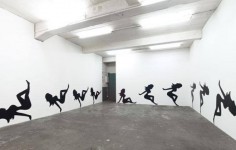VIRGINIA OVERTON
16 Mudflap girls (360°)
source: artnewsorg
Virginia Overton’s sculptural constructions are both a reflection and a product of this precarious existence — one that negotiates a contingent context of temporary relationships and incorrigible spaces. Where Overton’s practice may intimate a social terrain, it is wholly enacted in the physical register. These are heavy-duty yet teetering analogs that depend on its surrounding conditions (dimensions, gravity, temperature, moisture, tension, pressure, time, etc.) and its provisional relationships for stability.
The material elements that comprise Overton’s sculptural work must then be able to withstand constant displacement and renegotiation while holding its own position long enough. For Overton, the possible usages – both creative and functional – of construction materials and commercially produced objects lend itself to this task as well as carry a visual valence.
The wood beam, light bulb, plastic mirror, ratchet strap, chair, and metal ladder among others are part of a specific inventory of materials Overton uses to create her elegantly spare sculptures and temporary arrangements. In a recent exhibition at the Sculpture Center in New York, Overton presented two works in the catacomb-like spaces of the building that exemplified this approach. In one area, Overton wedged an orange utility ladder brought from her studio into a concrete space with same corresponding size, leaving the ladder dangling horizontally off the floor unmoored from its usual function — it is now a temporary art object until deinstallation.
In the choice of materials and their ad hoc configurations, Overton locates artistic practice continuous with the creative problem solving, or what she describes as ‘fixing’, that occurs in daily life. These are provisional solutions done with limited resources usually outside of any formal skill set. These are solutions to prop up; to hold together; to illuminate; to move things; to keep things going; to make something out of it. Overton continues these operations in her art production; however, nothing is necessarily broken that needs fixing here. For her, these are situations and spaces that give rise to the generative possibilities created from the need to figure things out.
A recent invitation for Overton’s exhibition in Basel, Switzerland, features a snapshot that she took in passing of a maroon flatbed pickup truck parked in a rustic setting. A single thin ratchet strap holds down an impossibly tall stack of wooden shipping pallets to the truck — perhaps just long enough for the unwieldy payload to reach its destination.
Similarly a few years earlier, Overton drove a borrowed pickup truck down South for her VA4398UV, (2006), project, collecting discarded objects in the cargo space along the way. When she arrived in Memphis from New York her truck resembled the one she would find later capture in a snapshot along the road. It is no coincidence that wooden pallets, utility straps, heavy machinery, and other materials occur in Overton’s work. These elements make up the pared-down, rugged aesthetics that characterizes her work.
By nature of their basic physical attributes and placement, these objects can also be a source of displacement and negotiation. The work is not only subject to surrounding conditions but can be a producer of it — they reflect, block, light up, and hold down. The centerpiece of her exhibition at Dispatch, Untitled (2010), featured two large sheets of slouching plastic mirror propped up on opposing walls by a wood beam, creating a reflected infinity from repurposed materials. As the mirror pieces buckled from the pressure of the supporting beam, multiple spaces proliferated in its imperfect, scratched reflections beyond the confines of the small gallery space.In her photographic work, Overton handles images much like physical material: to be manipulated, repurposed, put under pressure, and transposed. This includes representations of visual displacements such as images of reflections and illuminated liminal spaces.
Virginia Overton was born in Nashville, Tennessee and received her BFA, University of Memphis, TN. She lives in New York.
Recent exhibitions and projects include (selection) : Mitchell-Innes and Nash, NY (g), White Columns, NY (g), Republique-Galerie Chantal Crousel, Paris F (g), Elizabeth Dee Gallery, NY, (g), Basel 41, Basel, CH (g), PS1 MoMA, NY (g), Dispatch, New York, NY (s), Cheekwood, Nashville, TN (s), , Museum of Contemporary Art, Tuscon AZ (g), le Magasin-CNAC, Grenoble, F (g), Artlab at AMUM, Memphis, TN (g), Friedrich Petzel Gallery, New York, NY (g), Sculpture Center, Long Island City, NY (g), Powerhouse, Memphis, TN (s), Greene Naftali Gallery, New York, NY (g), Brooks Museum, Memphis, TN (s), Powerhouse, Memphis TN (s).
.
.
.
.
.
.
.
source: artthehighlineorg
Virginia Overton is known for sculptures and installations that incorporate raw materials, found objects, and often reused and recycled elements. Based on simple gestures, her work calls attention to the inexorable demands of scale and gravity in its attempts to fit into the surrounding environment. Pickup trucks have always played an important role in Overton’s work. The artist has frequently used trucks by turning them into platforms for artistic creativity including photographing trucks loaded with various found objects in their beds.
For the High Line, Overton transforms her own pickup truck into a sculpture installed on the stacked parking next to the High Line. The stacked parking is one of the sites next to the High Line that attracts the curiosity and amusement of passers-by for its unusual structure, and now it serves as a plinth for the artist’s work. By completely filling the bed of the truck with bricks, Overton references the now closed-off passageways on the High Line, which originally allowed trains to pass through the upper floors of warehouses and factories to drop off goods. Unable to transport goods itself, the pickup truck pays tribute to the history of the High Line and becomes a temporary monument to American car culture and life in today’s metropolises.


